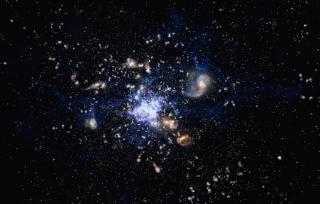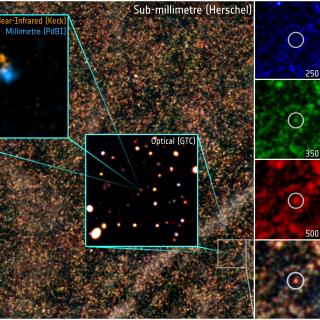Bibcode
Borsato, E.; Marchetti, L.; Negrello, M.; Corsini, E. M.; Wake, D.; Amvrosiadis, A.; Baker, A. J.; Bakx, T. J. L. C.; Beelen, A.; Berta, S.; Beyer, A.; Clements, D. L.; Cooray, A.; Cox, P.; Dannerbauer, H.; de Zotti, G.; Dye, S.; Eales, S. A.; Enia, A.; Farrah, D.; Gonzalez-Nuevo, J.; Hughes, D. H.; Ismail, D.; Jin, S.; Lapi, A.; Lehnert, M. D.; Neri, R.; Pérez-Fournon, I.; Riechers, D. A.; Rodighiero, G.; Scott, D.; Serjeant, S.; Stanley, F.; Urquhart, S.; van der Werf, P.; Vaccari, M.; Wang, L.; Yang, C.; Young, A.
Referencia bibliográfica
Monthly Notices of the Royal Astronomical Society
Fecha de publicación:
3
2024
Número de citas
12
Número de citas referidas
8
Descripción
We have carried out Hubble Space Telescope (HST) snapshot observations at 1.1 μm of 281 candidate strongly lensed galaxies identified in the wide-area extragalactic surveys conducted with the Herschel Space Observatory. Our candidates comprise systems with flux densities at $500\, \mu$m, S500 ≥ 80 mJy. We model and subtract the surface brightness distribution for 130 systems, where we identify a candidate for the foreground lens candidate. After combining visual inspection, archival high-resolution observations, and lens subtraction, we divide the systems into different classes according to their lensing likelihood. We confirm 65 systems to be lensed. Of these, 30 are new discoveries. We successfully perform lens modelling and source reconstruction on 23 systems, where the foreground lenses are isolated galaxies and the background sources are detected in the HST images. All the systems are successfully modelled as a singular isothermal ellipsoid. The Einstein radii of the lenses and the magnifications of the background sources are consistent with previous studies. However, the background source circularized radii (between 0.34 and 1.30 kpc) are ~3 times smaller than the ones measured in the sub-millimetre/millimetre for a similarly selected and partially overlapping sample. We compare our lenses with those in the Sloan Lens Advanced Camera for Surveys (ACS) Survey confirming that our lens-independent selection is more effective at picking up fainter and diffuse galaxies and group lenses. This sample represents the first step towards characterizing the near-infrared properties and stellar masses of the gravitationally lensed dusty star-forming galaxies.
Proyectos relacionados

Gas Molecular y Polvo en Galacias através del Tiempo Cósmico
Dos cuestiones fundamentales en la Astrofísica son la conversión de gas molecuar en estrellas y cómo este proceso físico depende del entorno en todas las escalas, desde sistemas planetarios, cúmulos estelares, galaxias hasta cúmulos de galaxias. El objectivo principal de este proyecto es el de estudiar la formación y evolución de galaxias a partir
Helmut
Dannerbauer

Formación y Evolución de Galaxias: Observaciones Infrarrojas y en otras Longitudes de Onda
Este grupo desarrolla varios proyectos extragalácticos en diferentes rangos del espectro electromagnético utilizando satélites y telescopios en tierra para estudiar la evolución cosmológica de las galaxias y el origen de la actividad nuclear en galaxias activas. En el aspecto instrumental, el grupo forma parte del consorcio internacional que ha
Ismael
Pérez Fournon